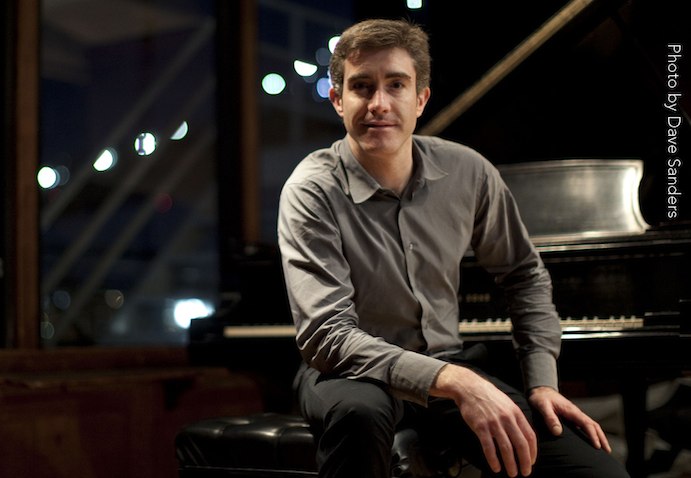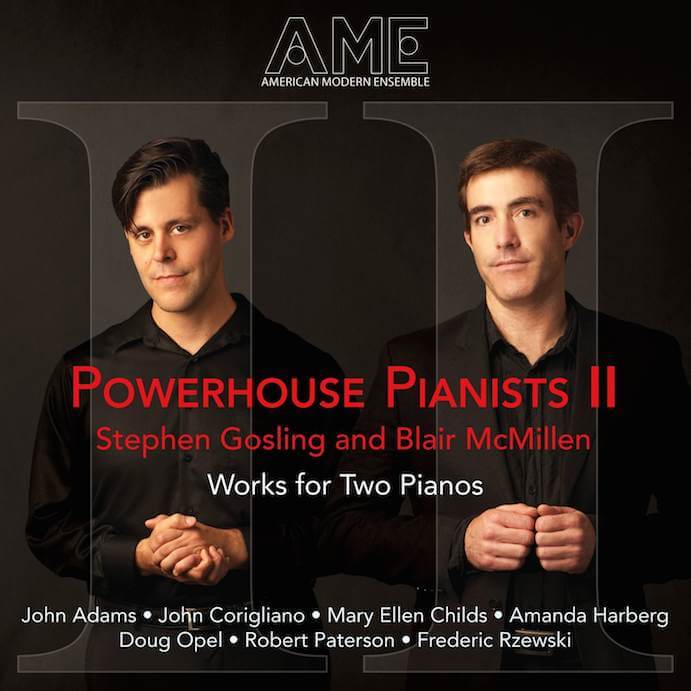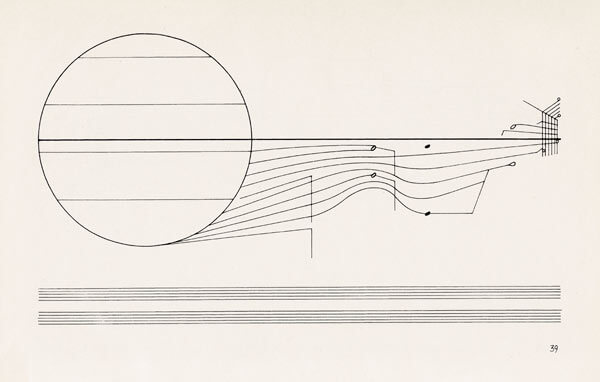Titles that make any sort of bold claim usually push me away. When I was asked to review Powerhouse Pianists II from American Modern Recordings, I was a little hesitant, but after listening to every track, this album is one that did not disappoint. Stephen Gosling and Blair McMillen are two monster pianists, and hearing them play as a duo brings energy to these works that transcends through the speakers and into the room. On every track, there is a conviction in the sound that gives it an aggressiveness that is firm but is more a result of careful preparation rather than bravado.
The album starts with Robert Paterson’s Deep Blue Ocean, a piece that focuses on gestures and minimalistic cycles rather than motives or themes. The music sparkles with notes that pop out of the repeated chords and ostinati that Paterson always seems to keep fresh and new to the ear. Paterson’s writing for the piano is very effective. He uses one range of the piano to establish a cycle before another idea is introduced in a new register, giving it a clear entrance before it also becomes a drone. Gosling and McMillen’s pedaling helps to give the weightless feeling of being in water. The piece was inspired by Paterson’s scuba trip to the Gulf of Mexico. Shortly after, the oil spill occurred while Paterson was composing Deep Blue Ocean. That event finds it’s way into the third movement with dense, dark chords that grow quieter and fall into lower octaves.
At first, Doug Opel’s Dilukkenjon has a form that seems to wander with no central idea to the piece, but by the end it’s clear that the wandering is the central idea. It opens with menacing soft, staccato figures that build into pounding dissonant chords. Suddenly, the tempo has left, and it sounds like children lost in the woods. Crescendoing trills, runs up and around different scales, children’s lullaby quotes, and other outbursts are exchanged back and forth before an ostinato emerges that brings the two back together.
Mary Ellen Childs’ Kilter is all about the struggle of balance or being thrown off kilter. It starts off fragile and still with the two pianos alternating the same single, soft tone. By the end of the piece, the single tone reemerges louder and with a completely different quality that seems manipulated somehow. The music consistently plays with the balance of the two pianos as they trade the same figures and musical gestures back and forth. The common theme, with its large leaps and jerky rhythm, is created by the two players accenting different notes back and forth within their separate figures. By the end, the theme comes back on its own as a single line, but McMillen and Gosling do a great job of making it recognizable in its earlier hocketed version.

Stephen Gosling
Amanda Harberg’s first movement from her Tenement Rhapsody entitled “Subway” is derived from the composer’s experience at Union Square Station in New York City. It starts with a jaunty theme that sounds like a mashup of ragtime, pop, jazz, and Beethoven. It quickly gets into soft sections that race along as the music builds, but quickly backs off. The quick pace and short motives keep the piece racing back to the opening material.
John Corigliano’s Chiaroscuro is hauntingly beautiful as it uses two pianos tuned a quarter-tone apart. He has two pianist do a pseudo call and response at first before pitting them against each other in the second movement. By the third, they actually come together on one piano for a time before falling apart again. Hallelujah Junction by John Adams is a great aural contrast to Chiaroscuro. The crux of the piece is the musical representation of the word ”hallelujah.” The rhythm of the word and the way the word is stressed (hal-le-LU-jah) is altered, delayed, and stretched in each section of the piece with expert phrasing, balance, and touch by Gosling and McMillen.

Blair McMillen
The album concludes with Winnsboro Cotton Mill Blues by Frederic Rzewski. This piece is raw and intimate, while other moments lend themselves to fits of rage. Rzewski based this ballad on a song detailing the working conditions of textile cotton mills in North Carolina. The music starts soft with low, dense alternating chords, but quickly builds. As the piece progresses, the dynamic and textural changes are more gradual and are like swells on the ocean: sure and consistent. Close to the end, the turbulence dies away and the original song is quoted. Soon the dissonant themes merge with the old blues song and creates a totally new aural experience. The piece ends in an unexpected, but satisfying way.
American Modern Ensemble did a fantastic job of programming and recording this album. All the pieces are presented like courses of a fine dining meal– each one has its own unique flavor and appeal. I will definitely take note of any record put out by American Modern Ensemble, no matter what the title is.





















